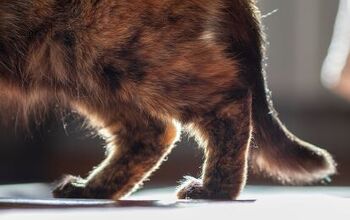What to Know About Dehydration in Cats

As a pet parent, it’s important to know about the risk of dehydration in cats. When the body is dehydrated, organs and bodily systems are negatively impacted and electrolyte imbalances occur, and if the dehydration worsens, it could be fatal.
There are multiple causes of dehydration, and there are several symptoms that will alert you to the fact that your kitty isn’t hydrated. Keep reading to learn the basics so you’ll know what to look for and what you can do to help prevent this problem.
What Can Cause Dehydration in a Cat?
Dehydration can be the result of a cat not getting enough moisture from their food and not drinking enough water. It can also occur if a cat has a health problem that is causing them to lose more water than they should. And if a cat isn’t feeling well and isn’t eating or drinking as much as a result, they can end up dehydrated.
Some of the various health problems and conditions that can lead to dehydration in cats include:
Also, certain medications, such as diuretics, can dehydrate cats, so it’s important to be aware of potential side effects whenever you give your kitty a medication.
How to Know If Your Cat Is Dehydrated
Because dehydration can affect your cat’s heart, body temperature, and more, it will lead to symptoms that something is wrong.
Here are some of the ways to check if your cat is dehydrated:
Check their gums
Your cat’s gums should be moist and pink. They should not be tacky or dry, which would indicate that your pet isn't adequately hydrated. Take a look at your kitty’s gums by gently lifting their lips. If you can, touch your finger to their gums to feel them.
You can even press in on the gums for a second to see how quickly the color returns to them. This is referred to as the capillary refill time or CRT. A normal capillary refill time is just one to two seconds. A slow CRT can indicate dehydration.
Check their skin elasticity
Referred to as skin turgor, your cat’s skin should be elastic when properly hydrated. When a cat is dehydrated, the skin won’t go back to its normal position immediately after being “tented.”
You can check this by gently grabbing the skin over the shoulder blades with your fingers. Pull the skin up to “tent” it, and then release it to see how quickly it goes back down. The longer it takes to go back down, the more dehydrated your cat is. If the skin stays up, the cat is very dehydrated.
Note: Cats who are older may have decreased skin elasticity, so keep that in mind when using this test.
Check for symptoms
Some of the symptoms associated with dehydration include:
- Decreased appetite
- Decreased water consumption
- Lethargy
- Weakness
- Sunken eyes
- Collapse
What You Can Do for a Dehydrated Cat
If you think your cat is dehydrated, don’t try to force them to drink water. Instead, have them examined by a veterinarian. Dehydration is a problem that you want to resolve promptly so it won’t worsen.
A vet will be able to examine your cat and run tests to determine if dehydration is to blame for their symptoms, and will also figure out the cause of the dehydration and the level of dehydration. Then, they’ll be able to give you a treatment plan that will likely include providing fluids that can help quickly rehydrate the body.
How to Prevent Dehydration in Cats
When dehydration is caused by an underlying medical problem, treating that condition with the guidance of your veterinarian can help prevent dehydration from occurring.
As a general rule, a cat has to drink roughly 4 ounces of water for every 5 pounds of body weight daily.
On a day-to-day basis, you can help ensure your kitty remains hydrated by taking a few simple steps. Here are some things you can do:
Provide fresh, clean water at all times
Your cat should always have easy access to fresh, clean water. You can leave more than one bowl of water throughout your home so they don’t have to go far to drink when they’re thirsty. Multiple sources of water can also be useful in a multi-cat household.
Many cats prefer drinking from flowing water because they perceive it as being safer to consume. So, if your kitty doesn’t drink much from their regular water bowl, consider switching to one or more water fountains. Products with filters will also help keep the water cleaner for longer. Just be sure to clean your pet fountain often and replace filters as needed.
As an example, check out the PetSafe Creekside Ceramic Pet Fountain. It holds 60 ounces of water, runs quietly, and has a dual filtration system to keep the water tasting and smelling great. It’s also easy to clean because it’s dishwasher safe, and it has a modern design. Plus, your cat can drink from the bowl or the tower.
Add moisture to your cat’s diet
Even if your kitty prefers dry food, it’s wise to add wet food to their diet, as it provides plenty of moisture that they can’t get from kibble. You may even notice that your cat drinks less water when they eat more wet food.
There are a variety of wet foods and treats available in a range of textures and flavors to suit each cat’s preferences, so you can find those that your kitty can’t resist. This can help ensure they get much-needed moisture even if they aren’t drinking a lot of water.
Another option is to add water or cat-safe bone broth to your pet’s dry food, especially if your kitty doesn’t like wet food.
Don’t Delay Treating Dehydration in Cats
Do what you can daily to help prevent dehydration, but know that underlying health concerns can be to blame for this problem. Also, because dehydration can progress quickly and cause a variety of issues throughout the body, it’s imperative that you work with your veterinarian to treat it promptly.
Join the PetGuide community. Get the latest pet news and product recommendations by subscribing to our newsletter here.

Lisa Selvaggio is a freelance writer and editor, and our resident cats-pert, with certifications in pet nutrition and pet first aid. She enjoys producing content that helps people understand animals better so they can give their pets a safe and happy home.
More by Lisa Selvaggio























